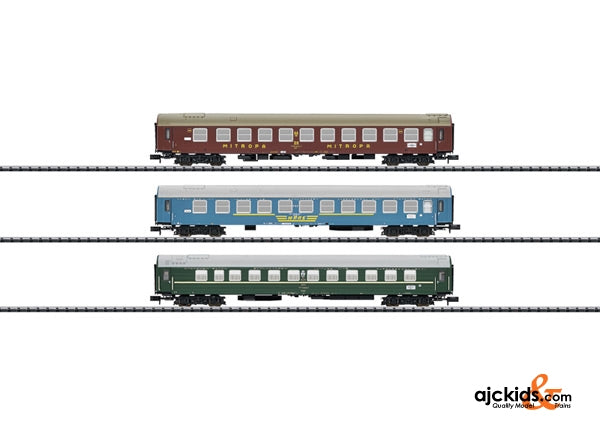Trix 15698 - EC 41 Moliere 3-Car Set
Prototype: 3 express train sleeping cars consisting of the types WLAB for the DR, WLABu for the PKP, and WLAB 52 for the SZD. Use: High-quality long-distance service, here in the EC 41 "Molière" around 1991/1992.
Model: The express train sleeping cars have close coupler mechanisms. Total length over the buffers 459 mm / 12".
Highlights: New tooling for the type UIC-Y sleeping car. Authentic train route.
One-time series.
EC 40/41 "Molière" "They only ran one winter", the three sleeping cars from the former socialist Eastern European countries in the EuroCity (EC) 40/41 "Molière". In fact, the "Molière" ran three unusual sleeping cars as through cars in the winter schedule for 1991/92. The EC 40/41 served the connections Dortmund – Essen – Düsseldorf – Köln – Aachen – Lüttich (Liège) – Paris as a regular route. In this schedule period, a DR sleeping car from Berlin, a PKP sleeping car from Warsaw, and an SŽD sleeping car from Moscow were added to this train in Aachen from the express D 240/241 "East- West Express" or they were transferred to the "Molière". These "socialist" sleeping cars were all based on the type Y that was generously used internationally and that had car ends slightly tapered inward. The cars were built in the GDR at the VEB Waggonbau Görlitz and the VEB Waggonbau Bautzen. They ran on type Görlitz V trucks without axle mounts and with coil springs. They were designed for a maximum speed of 140 km/h / 88 mph with their wheelbase of 2,500 mm / 98-7/16" inches. The longitudinal and cross members were made of rolled lightweight steel shapes that formed the underframe. The main cross members were designed so that the cars could also run with type Görlitz VI trucks. The car bodies consisted of the underbody, end walls, side walls, and the roof, and they were built on the surface as a rigid tube using lightweight profile shapes. The rubber diaphragms and two-part sliding doors formed the passageways at the ends of the cars. The compartment and corridor windows could be opened on the DR and PKP cars and folding doors with fixed steps at the ends of the side walls led to the interior. The SŽD sleeping cars had ribbed side walls, doors opening inward, one-piece windows, and additional coupler equipment for the SA3 center buffer coupler. The interior space of the cars accommodated ten sleeping compartments and one service compartment. The compartments were connected with the end entry spaces by means of a side corridor. The sleeping compartments could be occupied as 1st class compartments with one or two passengers or as 2nd class compartments with three passengers, depending on the demand. The beds were folded up against the compartment wall during the day. Each compartment had its own washbasin with a cabinet that could be covered, and the cars had separate tanks for supplies of warm, cold, and drinking water. The heating equipment for the water with its below-baseboard heat exchanger was electrically powered. If it failed, self-sufficient oil heating provided warmth. A pressurized ventilation system with automatic controls for summer and winter operation provided fresh air in the cars' interiors.
66616 LED lighting kit.
The "Molière" train consist can be lengthened prototypically with the 15682 car set and the 15683 add-on car.
EAN/UPC: 4028106156984



